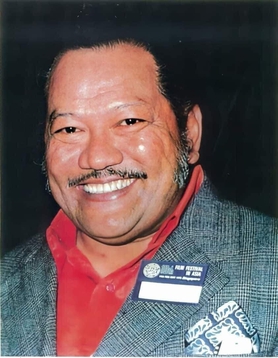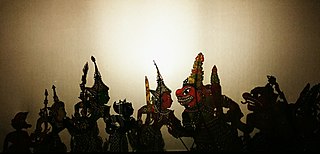Related Research Articles

The Kuntilanak, also called Pontianak, or Yakshi in Hinduism/ Hindu mythology is a mythological creature in Indonesia, Malaysia and Singapore. It is similar to Langsuir in other Southeast Asia regions. The Pontianak usually takes the form of a pregnant woman who is unable to give birth to a child. Alternatively, it is often described as a vampiric, vengeful female spirit. Another form of the Pontianak refers to the ghost or white lady of Southeast Asian folklore.

Tan Sri Loke Wan Tho was a Malaysian-Singaporean business magnate, ornithologist, and photographer. He was the founder of Cathay Organisation in Singapore and Malaysia, and Motion Picture and General Investments Limited (MP&GI) in Hong Kong.

Tan Sri Datuk Amar Teuku Zakaria bin Teuku Nyak Puteh, better known by his stage name P. Ramlee, was a Malaysian actor, filmmaker, musician, and composer famous in modern-day Singapore, Malaysia, Indonesia and Southern Thailand. Born in Penang, Malaya, he is regarded as a prominent icon of Malay language entertainment.

A bomoh is a Malay shaman and traditional medicine practitioner. The term is used mainly in Malaysia and parts of Sumatra, whereas most Indonesians use the word dukun. It is often mistranslated into English as medicine man or witch doctor. In colloquial usage, the term bomoh is often interchangeable with another type of shaman or dukun, the pawang, but they generally serve different functions. The bomoh is primarily a healer, herbalist, geomancer, and sorcerer. The pawang on the other hand usually specialises in rituals involving weather, nature, animals, and a good harvest. Their roles do overlap however, and both claim to act as intermediaries for the spirits and gods.

There are many Malay ghost myths, remnants of old animist beliefs that have been shaped by Hindu-Buddhist cosmology and later Muslim influences, in the modern states of Brunei, Indonesia, Malaysia, and Singapore and among the Malay diaspora in neighbouring Southeast Asian countries. The general word for ghost is hantu, of which there exist a wide variety. Some ghost concepts such as the female vampires pontianak and penanggal are shared throughout the region. While traditional belief does not consider all ghosts as necessarily evil, Malaysian popular culture tends to categorise them all as types of evil djinn.

Ali Baba Bujang Lapok is a 1961 Singaporean Malay-language black-and-white comedy film directed by, written by and starring Malaysian silver-screen legend P. Ramlee and produced in Singapore by Malay Film Productions Ltd. Based loosely on the story of Ali Baba from 1001 Arabian Nights, the film is occasionally self-referential and contains elements of anarchic comedy, burlesque comedy, satire and farce. The title includes the suffix Bujang Lapok because it is the third instalment in the Bujang Lapok series of comedy films that star the trio of P. Ramlee, S. Shamsuddin and Aziz Sattar. This film marked the feature film debut of Sarimah, who would go on to a long movie career, and is also notable as one of the few P. Ramlee films where he plays the villain.
The Bukit Timah Monkey Man, commonly abbreviated as BTM or BTMM, is a legendary creature said to inhabit Singapore, chiefly in the forested Bukit Timah region. The creature is often cited as a forest-dwelling hominid or primate, and is also accounted for as being immortal; however, its exact identity remains unknown, and its existence disputed. Documentation of the BTM is sparse and scattered; the creature is largely considered a product of local folklore.

The Asian Film Archive (AFA) is a non-governmental organisation in Singapore that preserves the film heritage of Asian Cinema. The archive is located at the National Library Building along Victoria Street, a five-minute walk from Bugis MRT station.
Mariam Baharum was an early Singaporean Malay film actress who was known for her work during the 1950s and 60s. She was nicknamed Mariam Tahi Lalat by her fans.

Hang Tuah is a 1956 Singaporean Malay-language historical drama film directed by Phani Majumdar. It is the first Malay film to be fully shot in Eastman colour film. It was released in Singapore by Shaw Organisation on 28 January 1956. The film was based on the legendary Admiral Hang Tuah of Malacca and his 4 sworn brothers; Hang Jebat, Hang Kasturi, Hang Lekir and Hang Lekiu. This film received the award for 'Best Musical Score' at the 3rd Asian Film Festival in Hong Kong in 1956 and an official screening at 7th Berlin International Film Festival in 1957, where it was nominated for the Golden Bear.
Screen Singapore was a film festival in Singapore held from 1 August 2005 to 31 August 2005, on the occasion of the 40th anniversary of the independence of Singapore, to celebrate the heritage of Singaporean cinema from pre-independence days to the present.

Malay folklore refers to a series of knowledge, traditions and taboos that have been passed down through many generations in oral, written and symbolic forms among the indigenous populations of Maritime Southeast Asia (Nusantara). They include among others, themes and subject matter related to the indigenous knowledge of the ethnic Malays and related ethnic groups within the region.
Rima Melati Sheila Adams born in Hong Kong, July 1, 1980, is a Singaporean model, actress, singer and TV personality. Most recently, she is a handbag designer.

Maria Menado, also known as Liesje Mandagi, is an Indonesian-born Malay actress, model, and producer who is known for her contributions to Malaysian cinema in the 1950s and 1960s. At the height of her fame she was voted “Malaya’s Most Beautiful” by Times Magazine and the “Best Dressed Woman in South East Asia” by publisher United Press International. In addition to acting, she also sang and went on to direct and produce films under her own production company, Maria Menado Productions. Menado is Minahasan and was born in Manado, Dutch East Indies.
Do Re Mi is a 1966 Malaysian Malay-language black-and-white satirical comedy film directed by and starring P. Ramlee. The concept was partly based on the idea of The Three Stooges with Ramlee playing the character Do. Its success led to two sequels, Nasib Do Re Mi and Laksamana Do Re Mi (1972), Ramlee's last film before his death.
Siti Mariam binti Ismail, better known by her stage name Mariani, was a Malaysian-Singaporean Malay actress, singer and model popular during the 1950s and 1960s. She was the older sister of Biduanda Saloma and sister-in-law of P. Ramlee. Mariani was one of the most popular actresses at Jalan Ampas Studios in Singapore at the time, dubbed the "Golden Age of Malay Cinema" at the time. She starred in more than 30 films over her 63-year career span.
Pontianak is a 1957 Malay horror film directed by Indian film director Balakrishna Narayana Rao, popularly known as B.N. Rao, and starring Maria Menado and M. Amin. Based on the Malay folktales of a blood-sucking ghost born from a woman who dies in childbirth, the smash hit premiered on 27 April 1957 and screened for almost three months at the local Cathay cinemas. Its success spawned two other sequels, Dendam Pontianak and Sumpah Pontianak. It is also said to have launched the Pontianak genre in Malaysia and Singapore, with rival Shaw producing its own Pontianak trilogy and several movies of the same genre were also made in Malaysia.

Malaysian folklore is the folk culture of Malaysia and other indigenous people of the Malay archipelago as expressed in its oral traditions, written manuscripts and local wisdoms. Malaysian folklores were traditionally transmitted orally in the absence of writing systems. Oral tradition thrived among the Malays, but continues to survive among Orang Asli and numerous Bornean ethnic groups in Sarawak and Sabah. Nevertheless, Malaysian folklores are closely connected with classical Malay folklore of the region. Even though, Malay folklore tends to have a regional background, with the passing of time, and through the influence of the modern media, large parts of regional Malay folklore have become interwoven with the wider popular Malaysian folklore.
References
- 1 2 Radford, Benjamin. "The Legendary 'Oily Man' Monster Terrorizes Malaysia". Live Science. Purch . Retrieved 12 June 2018.
- 1 2 Lee, Jacqueline (April–June 2021). "Man vs Nature: Speculative Fiction and the Environment". BiblioAsia. Vol. 17, no. 1. National Library Board, Singapore. pp. 34–37.
- ↑ Ong, Charmaine. "Orang Minyak or "Oily Man"". USC Digital Folklore Archives. University of Southern California . Retrieved 12 June 2018.
- ↑ "Curses and cripples for Hari Raya holiday entertainment". 18 April 1958. Retrieved 17 August 2018.
- ↑ "'Oily man' strikes fear in Malaysian village residents". 2 January 2012. Retrieved 3 January 2012.
- ↑ "Orang Minyak Rapist on the Prowl at HKL". Malaysian National News Agency :: Bernama . Kuala Lumpur. Bernama. 16 November 2005. Archived from the original on 30 September 2007. Retrieved 24 April 2011.
- ↑ Tulsi, Yogesh (2020). "An oily mirror: 1950s orang minyak films as Singaporean petrohorror". In Schneider-Mayerson, Matthew (ed.). Eating chilli crab in the Anthropocene : environmental perspectives on life in Singapore. Singapore: Ethos Books. pp. 338–385. ISBN 9789811441363.
- ↑ "Oily Man on the screen". 14 February 1958. Retrieved 17 August 2018.
- ↑ Serangan Orang Minyak at Sinema Malaysia
- ↑ Orang Minyak Archived 31 March 2008 at the Wayback Machine at Sinema Malaysia
- ↑ Pontianak vs Orang Minyak Archived 29 November 2012 at the Wayback Machine at Yahoo! Malaysia Movies